74: The Wills/Waddington gift scheme
The scheme to promote playing cards as gifts by means of inserts in Wills' cigarette packets apparently saved Waddington from their financial problems in 1931. Here are some details of the cards involved.
There is another article on this site dealing with the Wills scheme run by Waddington from 1932-34. However, John Berry, in his book on the Waddington Archive, gives details of the back designs, their makers and the numbers of packs produced from a production list that he found there. There are omissions, as he could only work with what was held in the Archive, but I thought it was worthwhile putting together as much detail as possible with illustrations of the cards involved.
Below is an example of an order form used by Waddington, as held in the Archive.

The inserts
These were made by both Waddington and by the printing division of Imperial Tobacco, Mardon, Son & Hall. Some were numbered on the backs and some were specific to a particular brand of cigarette, e.g. Star.

Waddington print for Star cigarettes, numbered, on pink, produced at their Keighley factory from February 1932. Referred to as Tom Thumb. The total number of insert single cards produced was 425 million.

Mardon, Son & Hall production, blue backs, numbered. This example has an overprint on the back in red announcing the end date of the scheme: 28th February 1934. The total number of inserts made is given in John Berry's book as 1,200 million from a history of Wills, so the rest must have been made by Mardon.
The full-size packs
Some of these are identifiable, whereas others are missing from the Archive, so a bit of detective work is needed. Also, some of the packs are from the makers' ordinary output, rather than being made specifically for the scheme. There are three categories of gift: patience sets, bézique sets and full packs (both single and double boxes), so I'll look at them separately. As far as I can tell, Mardon, Son & Hall packs were only produced for the scheme and never sold over the counter to the general public (unless there were surplus packs at the end of the scheme).
Patience sets:
These are either by Mardon or De La Rue/Goodall. They seem to have no design reference numbers. Of the examples below the top row were produced by Mardon, the bottom row by De La Rue with Goodall ASs. The junk design was used well after the end of the scheme, even in the post-war period with Waddington courts.
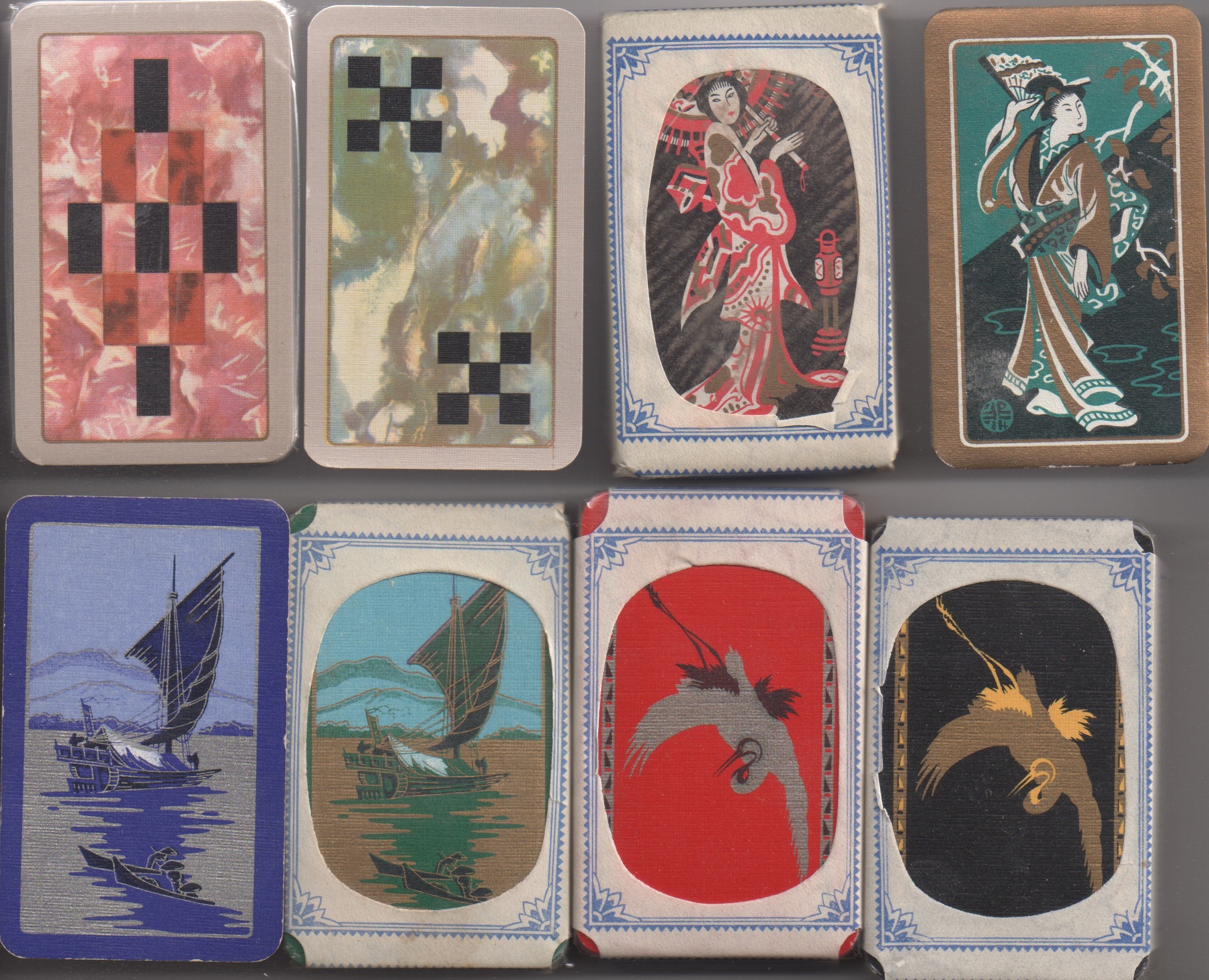
Bézique sets:
These also seem to have been produced by Mardon or De La Rue/Goodall, in the latter case using packs from their normal range.



Three examples by De La Rue; note that the top ace is anonymous, whereas the middle one is De La Rue's and the bottom one is Goodall's. The top one is from a print run with the 8S upside-down (three over five).
Full packs:
These were provided initially by Waddington, but it became increasingly obvious that demand outstripped the capacity of one firm. As early as 1932 both De La Rue and Universal were invited to join in and produce some of the packs. Then Mardon produced their own packs to complement the output. In the list below I have given the reference numbers used in the ordering process that are to be found in the Waddington Archive. The suffix letters indicate colour variants of the design. Some are not related to an identifiable design either because John Berry doesn't give an illustration or even a verbal description of it or there is no example in the Archive, but one or two can be identified from other sources and the reference number assumed. I have also given the number of each pack ordered as given in the records, some of which had repeat orders. Given the overall numbers of packs involved, it isn't surprising that we still see plenty of them today, even in an unused state.
All the packs below are by Waddington unless otherwise stated. The Waddington packs are of one of two types: the cheaper grade printed at Keighley by photogravure in black and gold or silver with the associated courts, and the more expensive packs printed in Leeds with a different set of courts. The latter seem to have worn quite quickly, presumably because of the large number of packs being produced, so two slightly different versions of the courts can be discerned. It's quite possible that extreme wear on these plates led to the introduction of a redrawn set of courts some time around 1935, which were used in more expensive packs, but not in the Wills scheme.

W5 courts from Keighley

W2.1 courts from Leeds

W2.11 worn plates, which may have been retouched; in particular, the collar of the JH is the same both ends with small green squares, unlike in W2.1, where there is an elongated bar at one end.
The edges were usually gold or silver, but occasionally mixed colouring was used, e.g. gold and green, or silver and blue.
1001A/E: 50,000 each
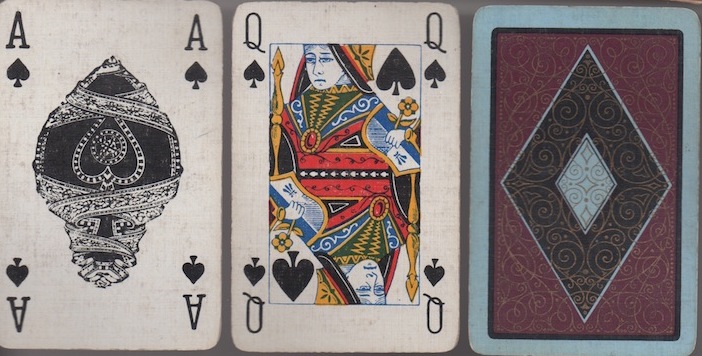
1002B
1002A: 50,000
1002B: 50,000
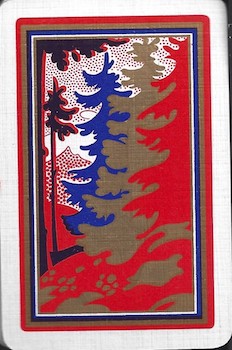 1003A
1003A
1003A: 75,000
1003I: 25,000
1004A/C/D: 50,000 each
1004E: 15,000
1005C?
1005C/D/E: 50,000 A possible candidate for this design, plus box.
1006B/D: 50,000
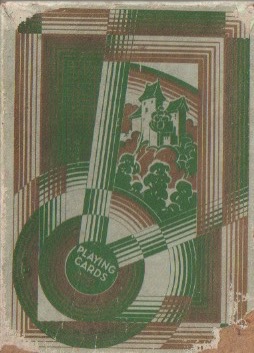 Box for 1007A
Box for 1007A
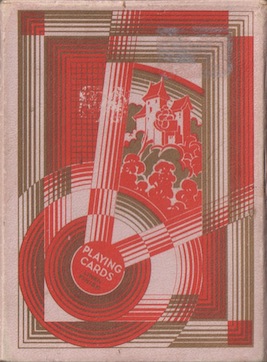 Box for 1007C
Box for 1007C
1007A/C: 50,000
1008A & B: 70,000
1009A & B: 50,000
1010A & B: 50,000
 1011A?
1011A?
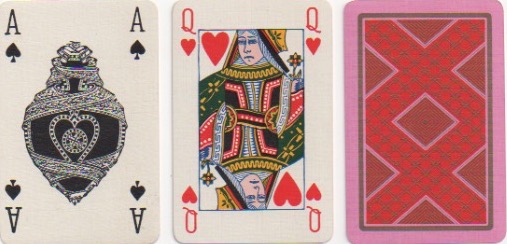 1011B?
1011B?
1011A/B: 50,000 each. These are possible candidates for the design, given the descriptions of the colour schemes in John Berry's list. In the lower example, which was originally unopened, the AS and AC have been packed upside-down, though the back seems to be double-ended, i.e. has no right way up.
1011C/D: 60,000 each. These are both described as being red + gold on yellow, with different coloured boxes in each case.
1012A/B: 50,000 each
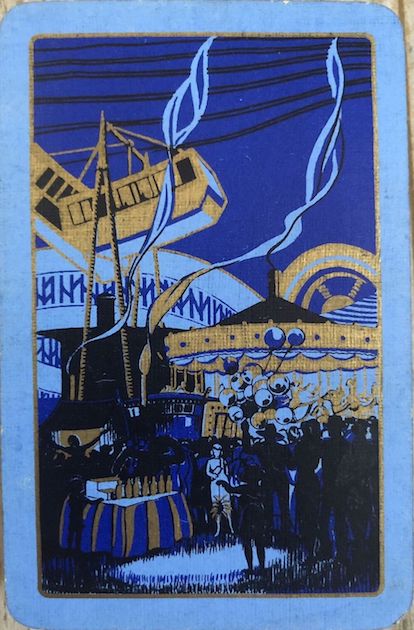 1013A
1013A
 1013B
1013B
1013A: 50,000 by De La Rue
1013B: 50,000
 1014B
1014B
1014A: 100,000
1014B: 100,000. Note that the example above is from the Ascot series, which was introduced into Waddington's normal range in July 1933. I don't know whether the 100,000 given in the orders for Wills includes packs destined for the Ascot series as well.
 1015A
1015A
 1015B
1015B
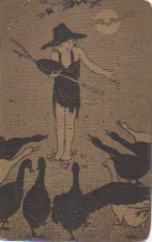 1015B, earlier version with no frame
1015B, earlier version with no frame
1015A: 100,000
1015B: 100,000
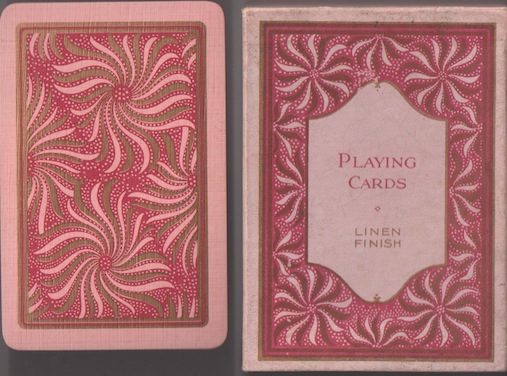 1016B?
1016B?
1016A: 50,000
1016B: 50,000. The image above is a possible candidate for the correct design; A is the green and gold version.
1016D/E: 50,000 each, marked as by De La Rue; D is blue and gold, E red and gold.
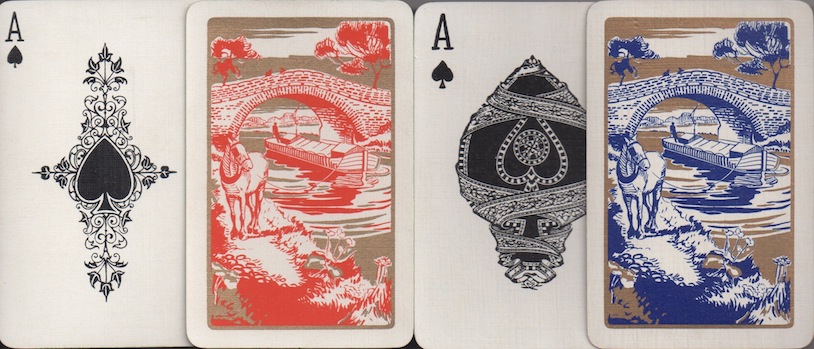 1017A/B
1017A/B
1017A: 50,000 printed by Universal PCCo.
1017B: 50,000 printed by Waddington
1017D: 75,000 as A, but printed by Waddington on pink board.
1017E: 50,000 as B, but printed on blue board.
 1018B?
1018B?
 1018C?
1018C?
1018B: 84,500 by De La Rue
1018C: 88,000 by De La Rue. The above examples are likely candidates for this design.
 1019D
1019D
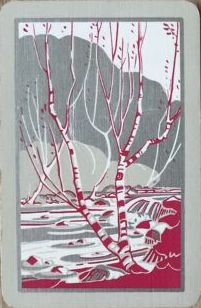 1019D (later printing, 1934)
1019D (later printing, 1934)
1019C: 118,000
1019D: 112,000. There was a slight colour change in the last order for these in February 1934, in which pink is replaced by white.
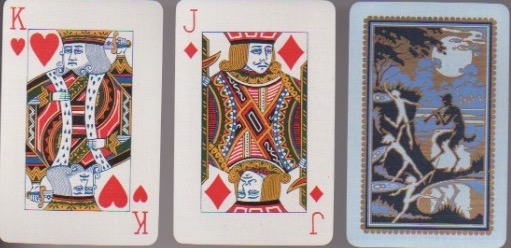 1020C
1020C
1020B: 50,000
1020C: 50,000
1021A/B: 50,000 each
1022A/B: 50,000 each. Designs 1021 and 1022 seem to be single-colour designs on white board printed at Keighley.
1025E: 60,000 by De La Rue
1025K: 45,000 by De La Rue
1027B/H: 50,000 each
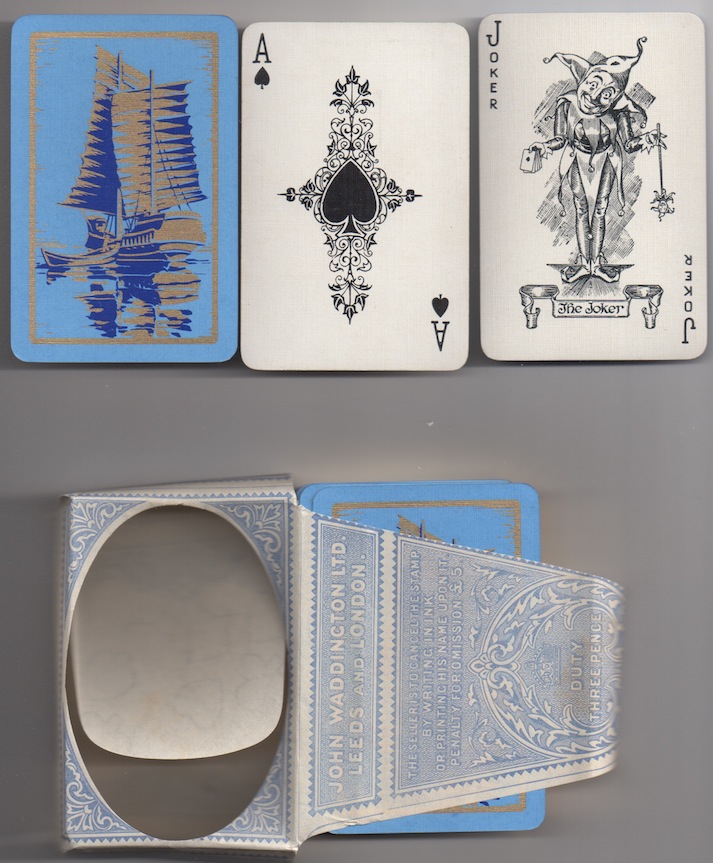 1029B
1029B
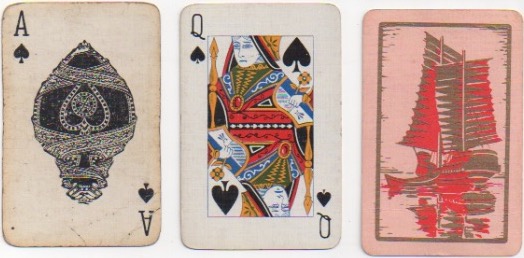 1029G
1029G
1029B: 50,000 by Universal. Note the tax wrapper is a Waddington one, so they must have been packed at Waddington's factory.
1029G: 50,000 by Waddington at the Leeds factory. These are the designs referred to in the order above from 17th November 1932. The design is incorrectly described as "Chinese sampan" (a small boat with oars), whereas it is, in fact, a Chinese junk.
1035A/1036A: 100,000 each, both in four colours + silver
 1037
1037
1037: 150,000
1038: 150,000 in full colour + white
 1039
1039
 1040
1040
1039: 185,000. Note the later joker, which may indicate that this example is from the second order from April 1934
1040: 185,000, the brown and blue butterfly design.
The following designs have no reference number.
 Nell Gwynne
Nell Gwynne
Nell Gwynne: 100,000
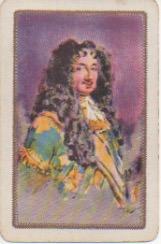 Charles II
Charles II
Charles II: 100,000
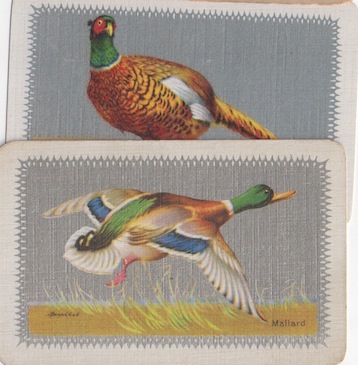 Pheasant and Mallard
Pheasant and Mallard
Pheasant: 85,000
Mallard: 85,000
There is one design that I can't attribute a number to yet. I know it in four colour schemes, which I can't align with any of the descriptions in John Berry's list from the Archive, and there are only two designs marked as being printed by Universal (Alf Cooke).
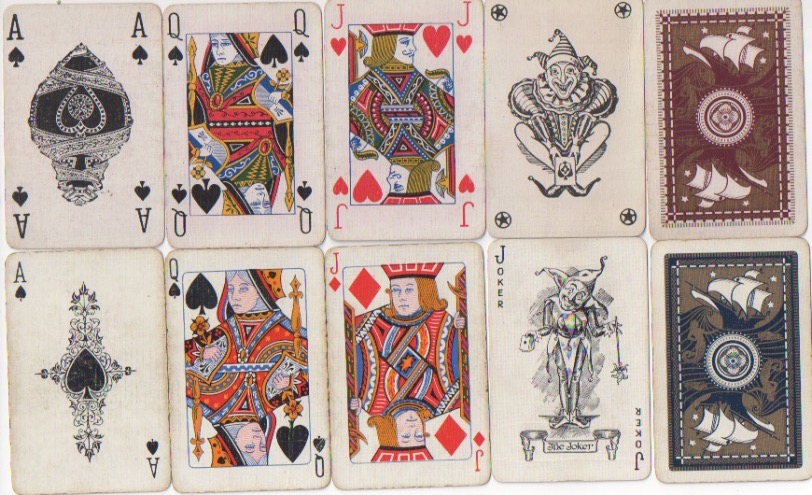

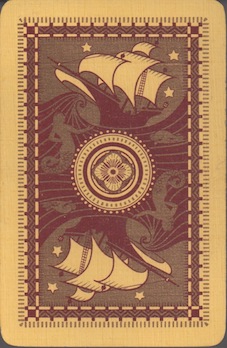
Other designs, by De La Rue/Goodall and Mardon, were used in the scheme, but no record of these appear to be included in the Waddington Archive. Most of the Mardon designs are well known and must have been produced in the same kind of quantities as those by Waddington. I give a few examples by each maker below.
De La Rue/Goodall
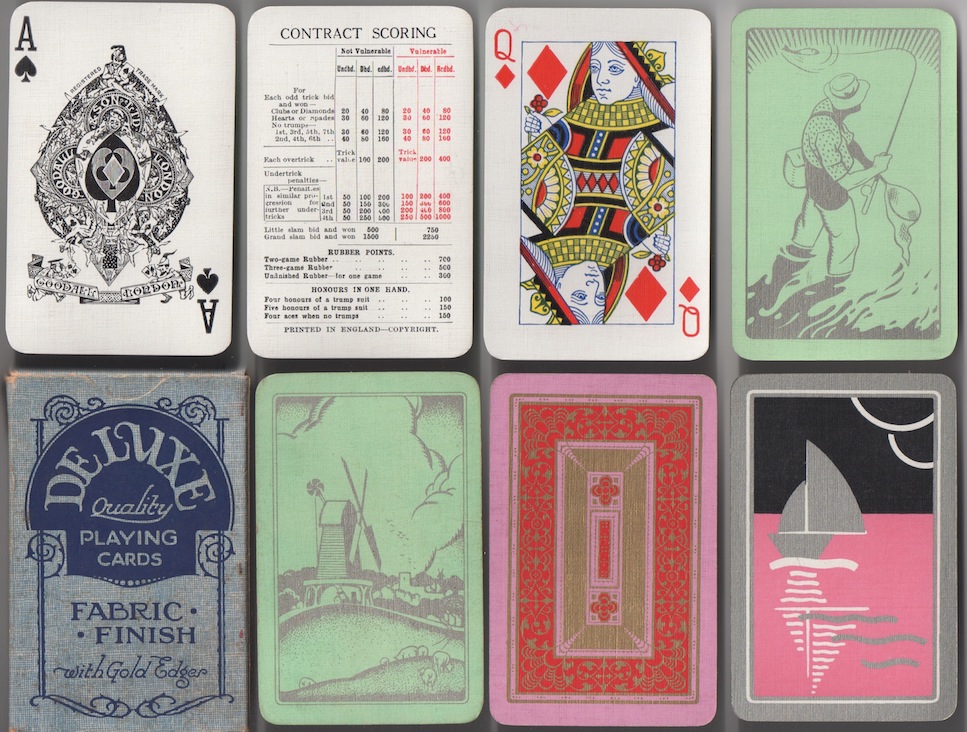

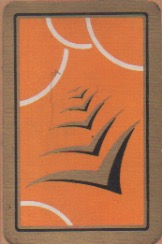

Mardon, Son & Hall
A few designs and the box used for single packs.
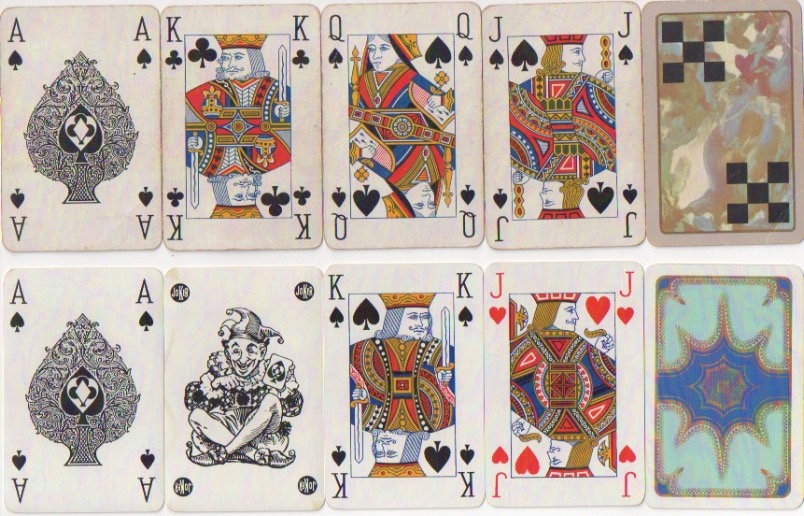
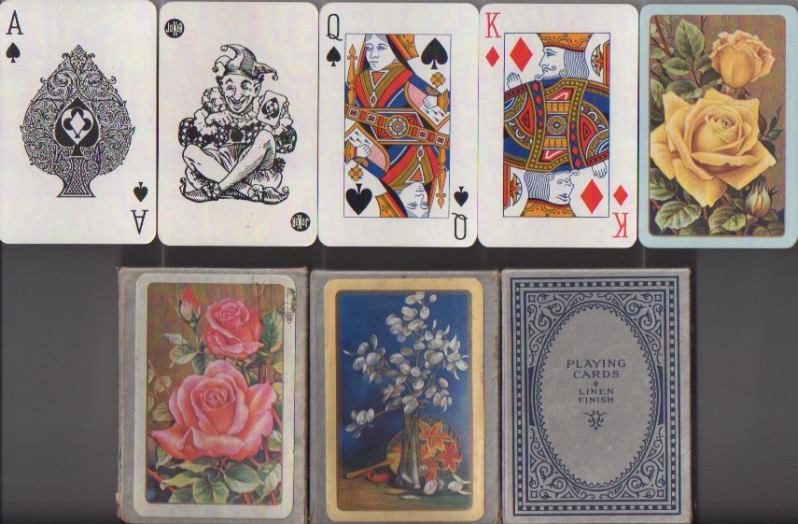
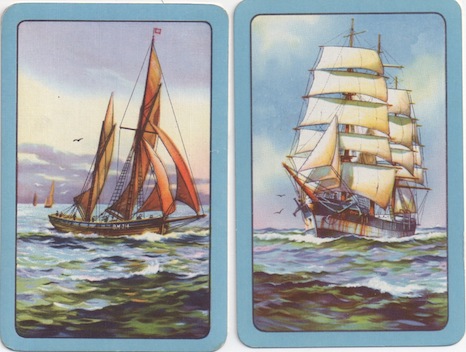
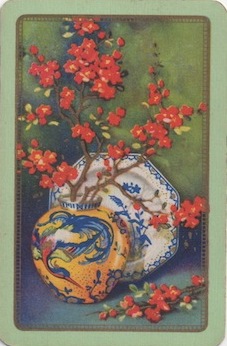
Universal
It's very difficult to tell whether Universal used other designs from their normal range. The design below is in a box also used by De La Rue, with a matching back stuck to it, which suggests the cards were used as gifts in the scheme, but they are not mentioned in John Berry's list. There's also a blue version.

I shall add more images, as and when I get them.
By Ken Lodge
United Kingdom • Member since May 14, 2012 • Contact
I'm Ken Lodge and have been collecting playing cards since I was about eighteen months old (1945). I am also a trained academic, so I can observe and analyze reasonably well. I've applied these analytical techniques over a long period of time to the study of playing cards and have managed to assemble a large amount of information about them, especially those of the standard English pattern. About Ken Lodge →

Leave a Reply
Your Name
Just nowRelated Articles

Hamlet Cigars
Advertising deck for “Hamlet mild cigars”, a Benson & Hedges product.

Will’s Cigarettes and Auction Bridge
In 1926 Will’s issued a set of 25 cigarette cards on Auction Bridge, presenting a range of hands ill...
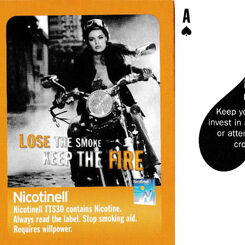
Lose the smoke Keep the fire
“Lose the smoke Keep the fire” playing cards to help quit smoking, published by Nicotinell, 2007.
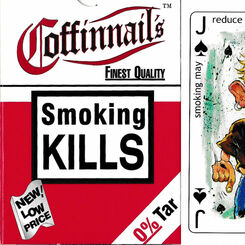
Coffinnails: Smoking Kills
“Coffinnails: Smoking Kills” playing cards highlighting the impact smoking has on life and health, 2...

52 ways to stop smoking
“52 ways to stop smoking”, offering positive help for anyone who wants to give up smoking.

69: My Collection
This is an archive list of my collection. I hope it will be of use and interest to others.

Wills 200th Anniversary
Double pack commemorating the 200th anniversary of W.D & H.O. Wills Ltd, 1786 - 1986.

50: Joseph Reynolds
A presentation of my database of Reynolds cards.
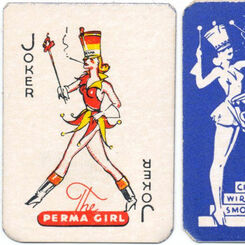
Permalon Ltd
Miniature playing cards advertising "Perma" smoking-related products featuring the "Perma Girl" on t...
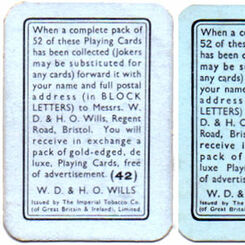
Wills Scheme
The W.D & H.O. Wills Playing Card promotion of the early 1930s
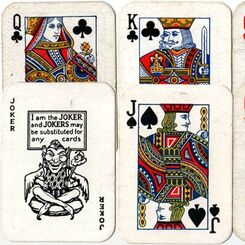
Wills Scheme page 2
W.D & H.O.Wills Playing Card scheme page 2

39: Mixed Packs
A number of mixed packs appear for sale from time to time, but it's important to sort out what is me...
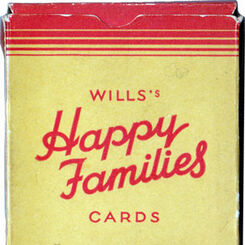
Wills’s Happy Families game
Wills’s “Happy Families” cards were issued by the Imperial Tobacco Company (of Great Britain and Ire...
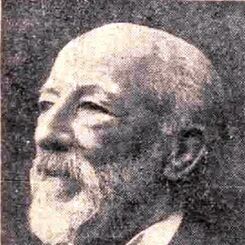
Heber Mardon (1840-1925)
Heber Mardon was born in 1840. With his father he founded the firm of Mardon and Son which, in 1863,...

29: James English
An overview of the courts and aces of spades produced by James English

5: De La Rue
In December 1831 Thomas de la Rue was granted his patent for printing playing cards by letterpress.
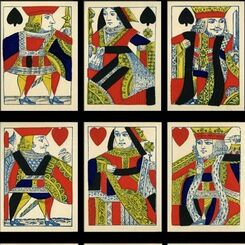
2: Still Collecting Playing Cards at 80
This is a personal account of some of my experiences collecting playing cards.

Mardon, Son & Hall of Bristol, branch of the Imperial Tobacco Company
A division of Imperial Tobacco, they appear to have made cards almost exclusively for the cigarette ...

Waddington’s Playing Cards
John Waddington Limited was a leading producer of playing cards and card games in the UK during the ...
Most Popular
Our top articles from the past 60 days


 Your comment here. Your comment here. Your comment here. Your comment here. Your comment here. Your comment here. Your comment here. Your comment here. Your comment here. Your comment here. Your comment here. Your comment here. Your comment here. Your comment here. Your comment here. Your comment here. Your comment here. Your comment here. Your comment here. Your comment here. Your comment here. Your comment here. Your comment here. Your comment here. Your comment here. Your comment here. Your comment here. Your comment here. Your comment here. Your comment here. Your comment here. Your comment here.
Your comment here. Your comment here. Your comment here. Your comment here. Your comment here. Your comment here. Your comment here. Your comment here. Your comment here. Your comment here. Your comment here. Your comment here. Your comment here. Your comment here. Your comment here. Your comment here. Your comment here. Your comment here. Your comment here. Your comment here. Your comment here. Your comment here. Your comment here. Your comment here. Your comment here. Your comment here. Your comment here. Your comment here. Your comment here. Your comment here. Your comment here. Your comment here.





















